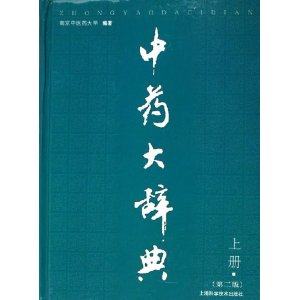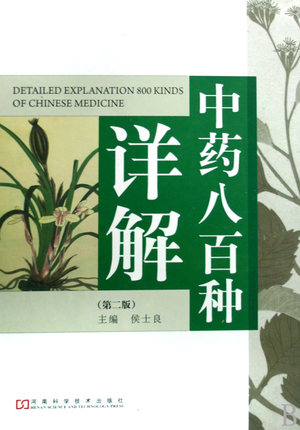 Title: Great Dictionary of Traditional Chinese Medicine
Title: Great Dictionary of Traditional Chinese Medicine
Author: Nanjing University of Traditional Chinese Medicine
ISBN: 9787532382712
Pages: 3875
Publishing House: Shanghai Science and Technology Publishing House
Publication Time: March-1, 2006
An Excerpt of Pine Pollen Record from the book:
Content Origin: Tang Materia Medica in Tang Dynasty (A.D. 657-659)
Names: Pine Flower or Pine Yellow (recorded in Tang Materia Medica)
Plant Source: Pollen of of Pinus massoniana or several species of the same genus; pick up the male panicles during its flowring period from every Aprial to May,naturally dry the panicles, rub the panicles to get the pollen and get rid of impurities.
Primitive morphology: Refers to the vocabulary entry “pine knot” for more details.
Habitat Distribution: Mainly distributes in provinces in Zhejiang, Jiangsu, Liaoning, Jilin, Hubei and so on.
Specification and character: Pine pollen is light yellow fine powder and shown as tiny round cells under microscope. It is with light weight and easily to be lifted in the air, with sense of smooth, mostly floating in the water, lighter smell and taste. The high quality pine pollen is those yellow, fine and smooth pollen with not impurities and great fluidity.
Chemical components: Contains oils and pigments.
Processing: Sun-drying or stoving after screening the impurities.
Property: Sweet and mild in property;
1). Record in Ben Cao Yan Yi/Materia Medica Derivatives: bland in taste,
2). Compendium of Materia Medica /Ben Cao Gang Mu in Ming Dynasty(A.D 1590): Sweet, mild, with no toxicity.
Meridian/channel Tropism: liver meridian and spleen meridian
Functions: Dispel the wind, invigorate “Qi”, astringe dampness, stop bleeding; treatment of dizziness, stomachache due to deficiency of the middle, protracted dysentery, damp sores or skin ulcers and traumatic bleeding.
1). Compendium of Materia Medica /Ben Cao Gang Mu in Ming Dynasty(A.D 1590): Moisten the heart and lungs, invigorate “Qi”, dispel wind and stop bleeding; and it can also be used to make liquor.
2). Ben Cao Hui Yan/Collected Statements on the Herbal Foundation: Treating protracted dysentery, relieving alcoholism,removing heat from blood.
3). Ben Jing Feng Yuan: Eliminate rheumatism, treat acne and damp sores/skin ulcers.
4). Sui Xi Ju Yin Shi Pu/The Diet Spectrum of Living with One’s Own Breath: Nourish blood for calming endogenous wind when it’s made to liquor.
5). Jiangsu Zhi Yao Zhi/Herbal Medicine Record of Jiangsu Province: Prevent miliaria, external use as traumatic hemostatic.
6). Sichuan Zhong Yao Zhi/Chronicle of Traditional Chinese Medicine in Sichuan: hemostasis with astringents; treatment of skin eczema and yellow fluid ulcers that is damp and does not scab.
Usage and dosage:
Oral administration: decoct with liquid with 3.72 grams to 7.44 grams(1 to 2 钱/Qian; 钱/Qian refers to cent/money, one Qian equals to 3.72 grams in Traditional Chinese Medicine ); soak the pine pollen in liquor or taken after mixing with water.
For external use: Directly apply to affected part, or apply after mixed with other medicines.
Attention: Ben Cao Yan Yi Bu Yi/Supplement of Materia Medica Derivatives: Over taken of pine pollen may cause upper pyrexia.
Supplementary Prescriptions:
1). Treatment of dizziness, headache due to head swelling, and skin diseases: Pick up the newly grown panicles and cut into small pieces, wrap 2 litres cut panicles in silk sacks and soak into 5 litres liquor for 5 days, drink 3 glasses of liquor on an empty stomach, and then get something to eat. (Pine Pollen Liquor recorded in Yuan He Ji Yong Jing)
2).Treatment of alcoholism, headache, dizziness, throat tightness, diarrhea and physical&mental atrophy: Stir-fry and mill the mixed herbs of 18.6 grams(5 Qian) Sicuan Coptis Chinensis(Coptis Chinensis from Sicuan Province in China) and 7.44 grams(2 Qian)liquorice, then evenly mix them with 50 grams pine pollen(baked); orally administrate 7.44 grams(2 Qian) mixed powder in the morning and evening with rice soup.(Record in Ben Cao Hui Yan/Collected Statements on the Herbal Foundation)
3). Treatment of gastric and duodenal ulcers, chronic constipation: Orally administrate 3.72 grams(1 Qian) pine pollen with warm water. (Handbook of Common Chinese Herbal Medicine of Guangzhou Army)
4). Treatment of protracted dysentery for months: Orally administrate 11.16 grams(3 Qian) pine pollen with rice soup.(Record in Ben Cao Hui Yan/Collected Statements on the Herbal Foundation)
5). Treatment of infant eczema: 3.72 grams(1 Qian) pine pollen, 3.72 grams(1 Qian) calamine powder and 3 egg yolks; decoct 3 egg yolks in a pan, get rid of the yolk residue and preserve the oil after the there is oil separated out from the egg yolk, then evenly mix the pine pollen and calamine powder with egg yolk oil, apply the mixed cream to affected part, but It won’t work for suppurative Part. (Published on Health Daily, 28 October 1955)
6). Treatment of diaper dermatitis: Apply the pine pollen tothe affected area. (Zhejiang Folk Herbs)
7). Traumatic hemorrhage: Apply the pine pollen to the wound. (Zhejiang Folk Herbs)
Discussions of various schools: Record in Ben Cao Jing Jie/Herbal Classic Interpretation: Pine pollen tastes sweet and benefit for the spleen, mild “Qi” could transport in the body to help the spleen transport the nutrients for the stomach, then reach to heart and lung, so pine pollen could nourish the heart and lung. Pine pollen as a “Qi-beneficiary”, it can warm the “Qi” so as to benefit for the “Yang Qi” of the liver; it tastes sweet so as to benefit for the “Ying Qi” of the spleen. Spleen regulates blood, sweet taste can balance/neutralize the spleen, so pine pollen can be used to stop the bleeding. Pine pollen has a fragrant and strong smell which makes it very suitable for making liquor.
 Title: Detailed Explanation 800 Kinds of Chinese Medicine
Title: Detailed Explanation 800 Kinds of Chinese Medicine
Author: Hou Shi Liang
ISBN: 7534939151, 9787534939150
Publishing House: Henan Science and Technology Publishing House
Publication Time: (January 1, 2009)
An Excerpt of Pine Pollen Record from the book:
Name: Pine pollen, pine pollen flower,pine yellow
Source: Pinus Massoniana Lamb., Pinus Tabulaeformis Carr., and Pinus Yunnanensis Franch mainly in Zhejiang,Jiansu, Lia ning, Jilin, Hubei, Yunnan Provinces.
Collection and procession: Collect the pine Catkins when pine trees bloom during April and May and then naturally dry the pine pollen catkins to eliminate the impurities.
Specification and character: Pine pollen is light yellow fine powder and shown as tiny round cells under microscope. It is with light weight and easily to be lifted in the air, with sense of smooth, mostly floating in the water, lighter smell and taste. The high quality pine pollen is those yellow, fine and smooth pollen with not impurities and great fluidity.
Identification: Under microscope, raw pine pollen is with elliptic cell with 45-55 micrometer length, 29-40 micrometer diameter, smooth surface and inflated gasbags at both sides which shows obvious reticular texture and polygonal mesh shape.
Property: Sweet and mild in property; medicine for liver and spleen. Tonify spleen&liver yang which could nourish liver and eliminate the wind, also with function of astringency and hemostasis.
Ancient and modern applications:
1.Tonifying spleen and qi, having great effect on gastropathy, duodenal ulcer as well as chronic constipation. The general dosage is 3 grams mixed with hot water. It also the function of anti-aging and senile diseases prevention such as prostatitis, prostatic hyperplasia, erectile dysfunction, climacteric syndrome, constipation, liver cirrhosis and fatty liver.
2. Eliminate inner wind. It can help wind dizziness, headspin, swelling, numbness and skin diseases. The method of application suggested is to dissove the pine pollen with certain concentration ethanol(liqueur).
3. Used for alcoholism, headache, dizziness, obstructed throat, diarrhea with clear intestinal juice and withering mental condition. The typical TCM formula contains pine pollen(30g), dried tangerine peel(15g), coptis chinensis root(15g), liquorice root(6g) and stir frying these ingredients and mill to powder, 6g a time twice a day(morning and evening).
4. Used for lingering dysentery with the dosage of 10g pine pollen taken by water in which rice has been cooked.
5. Used for infant eczema. External use the mixture of pine pollen, calamine and egg oil on infected part, 3 times a day.
6. Used to treat diaper dermatitis because its hygroscopic effect. Smear the pine pollen on infected skin.
7. Used to prevent traumatic bleeding because its stypticity function. External smear the pine pollen on the trauma or wound.
8. Facial beauty function mixed with poria cocos and whitish honey.
Usage and dosage:
Internal use: Decocted with water or soaked in liqueur with 3-6g pine pollen
External use: Apply to affected part after mixing with liquid
Modern researches:
Compositions of pine pollen include grease, pigment, protein, more than 20 kinds amino acid like methionine, lysine, valine, threonine, leucine and so on, 14 kinds vitamins, 24 kinds mineral element like iron, phosphorus, sulphur, selenium, potassium, calcium,zinc, manganese, copper and so on, 18 kinds natural active enzymes, plant hormone, aromatic compound and so on.
Pharmacologic actions include immunity enhancement, anti-aging function, lowering blood fat, digestive function improvement, inhibit of Benign Prostatic Hyperplasia, exciting hematopoietic function, promoting&strengthening the growth, expansion of coronary artery, increasing vascular toughness and protecting function on experimental hepatic injury.
